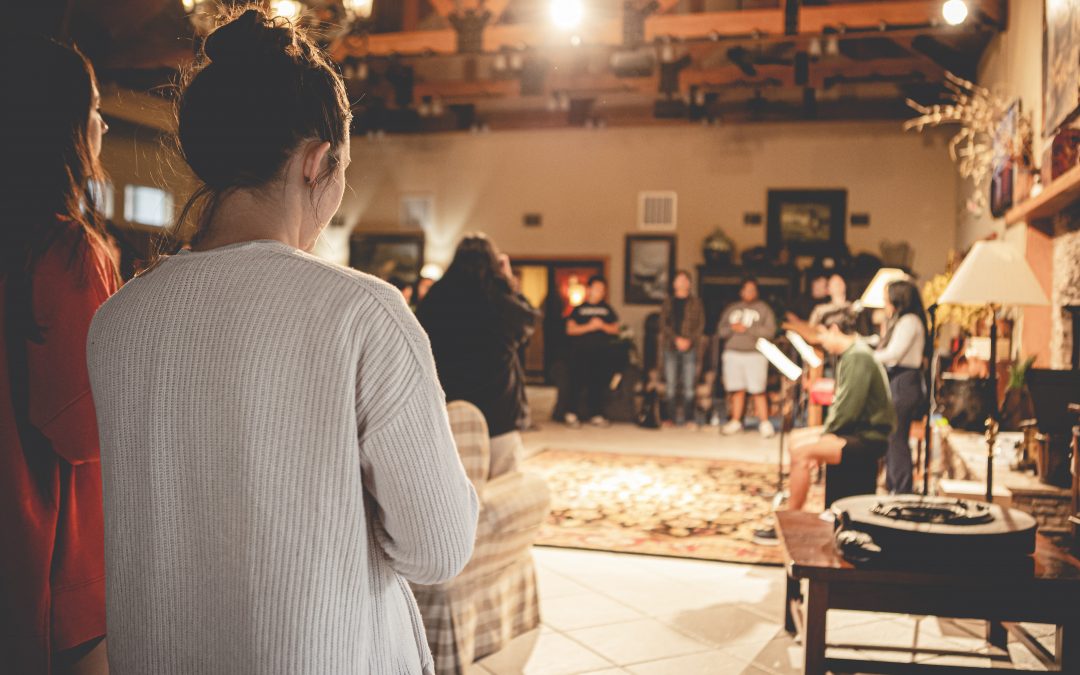
by Gary Reinecke | Oct 16, 2022 | Uncategorized |
In a post-Christian context, one of the challenges when connecting with people is discerning where to start. In our efforts to relate, serve, and ultimately build trust, sometimes we inadvertently do more damage than good. It can happen in subtle ways through words and actions that are intended to build bridges but, instead, create deep divides that are challenging to navigate.
Have you said something that was received with a surprised look, hurt, or even anger? I know I have. Fortunately, when this happens I have people around me that make me aware and those on the receiving end have been kind enough to forgive. There are times, though, when things are said that are offensive and insensitive that can lead to rifts in relationship if not quickly addressed. That’s what I would like to address here.
How to build relationships with people who have a different view than you
Listen – Listen to understand so that you learn where a person is coming from. This is easier said than done. Before you form a judgment – stop, remain curious and ask questions. When you feel the urge to share your own thought or relatable story, decide instead to listen and understand.
Empathize – If there is one thing that followers of Jesus need to lead the way in, it is the art of empathy. With the ability to put yourself in another person’s position, you can earn the right to ask questions. The only way to do this is by getting into the muck and mire of people’s lives. Watch Brene Brown on Empathy.
Nurture Trust – This is vital. Until you have implemented the first two, listening and empathizing, you will find it challenging to build trust. Nurturing trust is not a one-time event, but a repeatable process that needs to be reinforced.
In fact, the divisive nature in society has inspired some young leaders to create a toolkit focused on helping people create respectful conversations on various topics that are delicate in our society (politics, climate, gender, sexuality, etc.) and introduce tools that will allow people of various viewpoints to have healthy dialogue.
What to do when you have something to say
Contextualize your message. Paul was astute at relating to people from different worldviews than his own. Think of what he encountered throughout his ministry: navigating cross-cultural barriers, paradigms that were contrary to his, and an array of theological assumptions. A favorite example is when he encountered the “unknown God” (1) in Acts 17:22-23
So Paul took his stand in the open space at the Areopagus and laid it out for them. “It is plain to see that you Athenians take your religion seriously. When I arrived here the other day, I was fascinated with all the shrines I came across. And then I found one inscribed, to the god nobody knows. I’m here to introduce you to this God so you can worship intelligently, know who you’re dealing with.
The Message
Reflect on these questions to assess how you can adapt your approach
- What values do I need to hold true to?
- What issues are non-negotiables for me? Really?
- What issues am I willing to let go?
- What am I unwilling to risk in this conversation?
- How can I create a win-win for this conversation?
- What should I look for to determine if people are uncomfortable?
- What will I do when I encounter a sensitive topic?
- What possible subjects will this person find potentially offensive?
- How can I share what I need to share in a way that it can be heard?
- Who else could I include?
1 The Unknown God or Agnostos Theos (Ancient Greek: Ἄγνωστος Θεός) is a theory by Eduard Norden first published in 1913 that proposes, based on the Christian Apostle Paul ‘s Areopagus speech in Acts 17 :23, that in addition to the twelve main gods and the innumerable lesser deities, ancient Greeks worshipped a deity they called “Agnostos Theos”; that is: “Unknown God”, which Norden called “Un-Greek”.
Photo by Priscilla Du Preez on Unsplash

by Gary Reinecke | Oct 10, 2022 | Uncategorized |
What is mindfulness?
Mindfulness is “awareness that arises in the moment without judgment”. As Christian leaders it is imperative that we enter into conversations and remain in a mindful space for the benefit of the people we lead. When we can achieve that, we have the opportunity to nurture a place of refuge for our teams.
Is mindfulness a secular or non-Christian practice?
A common misperception of mindfulness is that you, as the coach, “empty” your mind. Nothing could be further from the truth. As a Christian leader myself, I want to help you shift your understanding of mindfulness to a focus on “stilling the mind.”
An important place where mindfulness “flows” into Cristian leadership is in the “stillness” that it creates: “Be still and know that I am God” (Psalm 46:10). Invite God into those places when you lack wisdom, peace, discernment, calmness, and confidence.
Mindfulness integrates seamlessly with Christian leadership. Here are some of the personal benefits that come with mindfulness that, incidentally, are scientifically verified.
Benefits of mindfulness:
- Decreases stress, anxiety, rumination, worry, depression, and pain
- Increases well-being and emotional regulation
- Guides us into being fully present (able to listen vs. lost in thought)
Practicing mindfulness with those you lead
A leader I was working with was sharing his journey of helping a church staff member navigate a challenging season. The staff member’s performance was not what he was accustomed to: flourishing ministry, empowered teams, and supportive colleagues. Instead, his reputation was suffering. As the lead pastor shared some of the difficult decisions he was struggling through, I offered to “hold space” (establishing a place of refuge) for him. This gave him an opportunity to sit quietly and discern what God wanted to say. Rather than chastisement – he felt empowered. I paused for a moment during our prayer and in silence asked the Holy Spirit to comfort, encourage and clarify what my friend needed to do in this uncomfortable situation.
Mindfulness facilitates a heightened level of sensitivity and discernment to identify moments to pause and “hold space” for clients. Building your mindfulness ability is just like developing any other habit: you need to focus on a certain muscle group, system in your body, or skill you want to master. Focus and consistent practice and exercise will accelerate your development.
7 habits to nurture mindfulness*:
- Breathe – take 3-5 deep breaths. Focus on opening your chest and expanding your belly on the intake, pause briefly, and exhale through your nose.
- Pray – find a quiet place, clear your mind, and pray.
- Walk – take a walk around the block.
- Practice – take the opportunity to stay present in the various conversations you have throughout the day.
- Gratitude – journal a list of things you are thankful for.
- Read – read a book for pleasure that is not related to your work.
- Meditate – find a passage of scripture that resonates and focus on it during breaks from work.
*Neuroscience supports the notion that if you can break a certain line of thinking for 90 seconds you can interrupt the thought
Reflection Questions to Enhance Your Mindfulness As a Christian Leader
- Describe those times when you remain fully present.
- What is happening when you allow your mind to wander?
- What is/are the triggers?
- When you realize your mind is elsewhere, how have you gotten back on track?
- Decide on one or more of the habits from the list above that you will adopt.
DISCIPLESHIP COLLECTIVE
October 17 is right around the corner, and you know what that means… Our 5 Discipleship Coach Habits Webinar is finally launching! After putting a lot of time and effort into creating this training approach to disciple making, we are so excited to finally begin this journey with anyone who feels ready to take the next step in their discipleship coaching. The cohort launches on October 17, 2022 from 10am-3pm PST.
Photo by Milan Popovic on Unsplash

by Gary Reinecke | Oct 3, 2022 | Uncategorized |
What do birds have to do with making disciples that make disciples? Bear with me for a minute–I promise there’s a connection.
You may have heard of the term “imprinting”. Famous zoologist Konrad Lorenz famously describes the process of imprinting occurring when an animal forms an attachment to the first thing it lays its eyes upon after hatching (McLeod, 2018). This is most often associated with geese when the farmer becomes its “parent”.
If the gosling is not parented by a goose, then the farmer will take the place of the parent. Because of this, the gosling will never learn how to fly. The farmer is imprinted upon the bird, thus preventing the goose from learning how to become what it was created to be.
Let’s go back to the beginning: what do birds have to do with making disciples that make disciples? Maybe you already see the connection. When a Christian begins the process of discipling a new believer, they run the risk of imprinting themselves onto the young disciple. The one who is new in faith may begin to follow everything their discipler is doing and begin to look more and more like them. This poses a danger to the developing believer because it takes away the focus of Christ and replaces it with the one who is leading.
This is not always done on purpose. Yet without maturity and discernment, a disciple maker may end up creating mini versions of themselves instead of creating followers of Christ. This prevents disciples from maturing into who they were created to be. We are not meant to be like those around us, but we are meant to become more like Christ. So how do we avoid this process of imprinting?
Whose imprint are you leaving on the newest disciples in the ministry you lead?
In the church where I grew up, there were two influential leaders under whom the church flourished. Skyline Wesleyan Church was planted by Orval Butcher. He planted a thriving church and pastored the families that were drawn to this “Christ-centered family church.” Pastor Butcher was a people’s pastor. The church grew under his leadership to over 1,0000, which is quite an accomplishment given the personal nature of his ministry. His successor was Pastor John Maxwell. Many have read his books or heard John speak and been inspired by his ministry. John’s mantra is “everything rises and falls on leadership”.
Imagine being under the leadership of two very influential church leadership and discipleship models. Regardless of the other models you’ve experienced throughout your faith journey, the imprint on your mind and spirit remains to this day. The models of Skyline Wesleyan Church gave me someone to look up to, emulate and aspire to be like as a follower of Jesus and as a leader. At some point along my journey, I needed to discover and (eventually did) lean into who I was as a follower of Jesus apart from the models that left their imprint on me.
How do we imprint Jesus on the newest followers?
We must first always point people towards holiness. We must pursue and model the life of Christ in every aspect, to the point that nothing in ourselves is taking the throne, or, keeping with the imprinting analogy, the “first gaze”. One of the truest ways to disciple a young believer is to show them who Christ is. That requires continually bringing them back to scripture and modeling a life of holy living. 1 Peter 1:16 states: “You shall be holy, for I am holy.” As we take on the disciple maker role, it is important to be reminded that others are always watching. So we must ask ourselves who they are seeing: us or Christ?
Secondly, it is important to look at who has been discipling us and where our influence is coming from. Has there been anyone upon whom we have “imprinted” when we were young in our faith? Looking back and reflecting upon our own discipleship journey can help us become more aware of the pitfalls we find ourselves in. We often repeat what was imprinted on us, thus creating a pattern – healthy or unhealthy.
Lastly, when we disciple, we must help people see for themselves who they were created to be. If we are faithful in our leadership, stripping away our own biases, then we must allow the Holy Spirit to do His work in the formational process. Our job is simply pointing people towards Jesus and allowing Him to work in the transformation towards becoming more like Him.
Church models, whether prevailing or micro, may not be as critical here as long as leaders don’t create a dependency on their leadership. What matters when a person enters a large group gathering versus a small group gathering is the direction they are pointed. Are they walking towards Christ, or are they emulating another individual?
Following are reflection questions to help you discern the imprint you and your church community are making on the newest disciples.
Reflection Questions:
Whose image are you imprinting when you disciple a new believer?
How can we challenge church leaders to make disciples without making mini followers of ourselves?
What role do small groups and formational communities play in your disciple making process?
DISCIPLESHIP COLLECTIVE
October 17 is right around the corner, and you know what that means… Our 5 Discipleship Coach Habits Webinar is finally launching! After putting a lot of time and effort into creating this training approach to disciple making, we are so excited to finally begin this journey with anyone who feels ready to take the next step in their discipleship coaching. The cohort launches on October 17, 2022 from 10am-3pmPST.
LEARN MORE
Photo by Jonny Gios on Unsplash

by Gary Reinecke | Sep 26, 2022 | Uncategorized |
I heard this statement a while ago. I’m not certain, but I believe it is attributed to Neil Cole.
“What you win them with is what you win them to.”
What does this statement mean?
In the previous 3 blogs I suggested there are two primary church planting models on the landscape today: the prevailing church and micro-church. For the sake of comparison, these are at opposite ends of a continuum described as attractional (come and see) vs. missional (sent out). I can get a little “geeked-out” here, so my apologies in advance.
Let’s return to the question. How do you interpret this statement?
“What you win them with is what you win them to!”

(I borrowed this infographic from another blog.)
It might be helpful if you view this as an objective analysis rather than a critique. My intent is not to portray one model superior to the other, but each distinct from the other.
Let’s begin with the prevailing church approach.
In its simplicity, this model is keenly focused on launching the corporate gathering, in many cases using small groups to assimilate people. When done with intention, the small groups continue the disciple making process. The other opportunity that this approach offers is service. This type of service is church-centric, at least in the beginning (aka “set-up and tear-down”). It’s a great way for people to use their gifts and abilities. When done well, these environments can form the basis for a disciple-making culture.
What you win them with is what you win them to!” The priority with this model is attracting people to a large group gathering. When done with excellence, people will come. Case in point: I am involved in the launch of The Refinery Church which was highlighted in our recent blog on the prevailing-model church. The planters, Casey and Aimee Graces, have been working through the launch process and one of the steps was a series of practice services. As a member of the Welcome Team I was observing a woman walking by the elementary school where we rent space. She cautiously approached one of the members of our team and began to ask questions about the church: how long it had been meeting, service time, childrens’ programs, etc. She then paused and began to share that it has been a long time since she had been in church. The next thing I observed were tears streaming down her face. We escorted her into the auditorium and that morning she received Christ. The presence of a new church in her community was new and attractive. She returned the next week with her daughter. That is one reason why church planting is so powerful in the disciple making process. The corporate gathering was attractive and instrumental in helping this person take the next step on her spiritual journey.
The tendency I’ve observed this time and time again with planters using this approach is that because of the rush (emotionally and practically speaking) to get the corporate gathering dialed-in and launched, disciple-making environments like small groups tend to come later. A common problem that arises is that the energy and human resources required to keep the corporate gathering running can detract from developing disciple-making communities. At some point, the church planter needs to back-fill and could be setting themselves up for, in many cases, a re-launch.
The micro-church approach creates a different dynamic.
The starting point is with every-day Christians engaging with people in their neighborhood, place of work, or community as they “do life” (shopping, sports, or school, for example). Once they have relational trust, the planter begins to gather in various locations where people most naturally come together. Whether in homes, parks, or offices, these groups form the nucleus of the disciple-making DNA.
What you win them with is what you win them to! The priority is establishing relationships as you go about your daily activities and engage with people on their disciple-making journey. If and when it is appropriate, you invite them into a small group gathering. This is a powerful church-planting strategy for people to take the next steps on their spiritual journey because of the strong sense of belonging that small groups can cultivate. This is how One City Fishtown has seen God at work through their micro-church strategy.
For example, one evening as Shaun was walking, he approached his neighbor simply to say hello. When Shaun asked him how he was doing, he confided in him that his partner of 17 years had randomly left him with no warning. Feeling broken and confused, he asked Shaun to let him know when One City would be having a prayer night so that he could join. It was in this moment the Solidays realized their presence in the neighborhood was beginning to establish trust and build bonds among the people living right in their midst.
The tendency with small gatherings is that people can become inward focused. It is a natural phenomenon: when a group of people gather, it is natural to allow the comfort that the group achieves to drive the group so the focus becomes the needs of the individuals in the group to the exclusion of outsiders. Like the prevailing church model, the mission to make more and better disciples must be held high to remind people again and again why they exist.
So how do you interpret this statement: “What you win them with is what you win them to”?
Both of the interviews we shared for the prevailing church and the micro church models face the same challenge: holding the banner “make more and better disciples” high and above the other agendas that groups, large and small, fall prey to. The challenge: keep the main thing the main thing!
Questions for your Reflection
- What do you resonate with from these two models?
- What is confusing?
- How are you keeping disciple making the main thing?
- How would you describe your philosophy of ministry?
- What can you do to develop and maximize your strategy?
- Who do you need that can help you make those changes?
- What is your next step(s)?
5 DISCIPLESHIP COACH HABITS COHORT
ONLY 5 WEEKS TO GO!
October 17 is right around the corner, and you know what that means… Our 5 Discipleship Coach Habits Webinar is finally launching! After putting a lot of time and effort into creating this training approach to disciple making, we are so excited to finally begin this journey with anyone who feels ready to take the next step in their discipleship coaching. The cohort launches on October 17, 2022 from 10am-3pmPST.
LEARN MORE
Photo by Akira Hojo on Unsplash

by Gary Reinecke | Sep 18, 2022 | Uncategorized |
Discerning the Call
“‘We’re going to Philly, aren’t we?’ I asked. ‘I think we are,’ Krissy said, with tears in her eyes as we flew over the skyline of Philadelphia. We knew at that moment God had placed a love in our hearts for the people of this city.”
Let’s back up for a little context. Shaun and Krissy Soliday spent several years in Kentucky, discerning what God may be calling them to. After finishing seminary at Asbury, they took time to deeply pray about what was next. It was clear God was asking them to follow Paul’s lead to “Preach the gospel where Christ was not known, so that [they] would not be building on someone else’s foundation” (Romans 15:20).
Shaun and Krissy had been married a little over a year when they first felt the call to plant a church. Fast forward to year 5, one toddler and twins on the way, they are now living in the city of Philadelphia in the neighborhood of Fishtown.
Discerning where to plant a church was just the beginning of seeing God at work in their lives. From the start, they boldly asked God to lead them to a place where their hearts would break for the people around them. God generously answered this prayer and led them to the community of Fishtown, where they are slowly building deep relationships with their neighbors.
Discovering the Context
With a history of deeply-rooted community, Fishtown is a unique subsection within the city of Philadelphia. The old streets speak the stories of those who came before and the new structures shed light on where the city is headed. Through the hustle and bustle of the rising area, there sits a city caught between an old community and an upcoming movement.
Knowing this reality has helped Shaun and Krissy discern what type of church plant the community of Fishtown needs. As they prayed through what model God wanted them to build, they never felt peace with the idea of starting a traditional church.
The idea of a house church was never something at the forefront of Krissy’s mind. She and Shaun had only known a traditional (or prevailing) church model, and it was hard to break away from it. After spending a year living in Fishtown and getting to know their neighbors and coworkers, God began to widen their vision and break down the barriers that existed in their minds.
More specifically, as Shaun and Krissy were praying one evening, God brought to mind a specific neighbor to Krissy, about whom she said, “I know our neighbor has experienced a lot of pain in her life. She hates religion and anything to do with spirituality. She would never walk through the doors of a church; however, she would come over for dinner and spend time with us as a family.” It was then that God revealed to Krissy and Shaun the church needed to start in their home.
The city of Fishtown is filled with many people searching for meaning while fleeing from a painful past. Often these stories have led people to distrust the church and anything associated with it. This is the precise reason Shaun and Krissy are starting a micro church in their home. They know God wants them to enter into the lives of those around them on a deeper level and build trust in order to share the gospel with them.
Mapping out the Journey
Although the model is small, Shaun and Krissy expressed that God would be nevertheless doing great things. They will still gather weekly for worship, a message, and prayer, but the time will be more intentional as they have more room for conversation. They will meet to break bread with one another and see how they all have a place at the table in God’s Kingdom. There will be no programs or additional services but a simplified time to gather and experience the presence of God with one another.
Small groups, mentoring, and one-on-one discipleship will still occur, but unlike the 15-20 member Sunday gathering, these groups will be even smaller in order to help people build bonds of trust and go deeper in their faith journey. The goal is to have intentional conversations and gatherings in every ministry setting they offer.
It is the hope that One City will begin the process of building house churches all over the city of Philadelphia in the years to come (i.e. One City Arimingo, One City Kensington, etc). From the start, it has always been Shaun and Krissy’s desire to plant multiple churches. Within the next two years, they hope to disciple another couple or individual to start a church in their home, beginning the ripple effect of multiplication.
Once more churches have been planted, they plan to establish a monthly corporate gathering where all One City churches can gather under one roof to worship together. The goal of this will be to know they are a part of something larger while also belonging to a smaller community of believers.
Preparing the Heart
Throughout Shaun and Krissy’s journey it was apparent to them God was directing their steps along the way. One thing they have both learned from this process is to always be committed to prayer. They knew that without the power of the Holy Spirit they would fail. There have been many times in their journey where they didn’t know what the next steps were or what God was doing – but in everything, He gave them the wisdom and clarity to do what they needed to do at the right moment.
In addition to prayer, one way Shaun and Krissy prepared their hearts for the journey was making sure they were healthy from the start – spiritually, mentally, and physically. They were committed to being mentored, counseled, coached, and to remain in accountability groups as they prepared for this next step in their lives. They knew the importance of taking care of their marriage and individual selves while doing God’s work.
Looking back and reflecting
In retrospect, it’s easy for them to see the areas they could have approached in a different way. For Shaun and Krissy, this would mean practicing a posture of patience. They were both eager to start a church once they moved to the city but it has taken them over a year to discern what God actually had in store for them. A year of waiting meant a year of building intentional and trusting relationships with those around them, which revealed to them the model God had for them all along. Without that year of uncertainty, they wouldn’t have known the path God wanted them to take. Patience can be one of the most difficult things to walk through, but if we lean into prayer, it becomes clear when God is preparing something special for us.
Celebrating what God is doing
As much as we can reflect on the ways we would go about our paths differently, it’s important to celebrate what God has done and is doing currently. The Solidays are making great strides in building God’s church in Fishtown. They are establishing relationships and gaining trust with the very people that live next door to them. God is opening doors for more spiritual conversations and breaking down barriers that felt impossible to move before. What seemed like a far-off dream and unclear picture is now a reality of God birthing something new.
Three ways to pray for One City Church
- Launch Team – That God would call and raise up leaders to join the team
- Receptive Hearts – For those the Shaun and Krissy meet to be open and receptive to the Gospel
- Spiritual Warfare – For God’s protection over their family as they reach the dark places
5 DISCIPLESHIP COACH HABITS COHORT
ONLY 5 WEEKS TO GO!
October 17 is right around the corner, and you know what that means… Our 5 Discipleship Coach Habits Webinar is finally launching! After putting a lot of time and effort into creating this training approach to disciple making, we are so excited to finally begin this journey with anyone who feels ready to take the next step in their discipleship coaching. The cohort launches on October 17, 2022 from 10am-3pmPST.
LEARN MORE
Photo by Terren Hurst on Unsplash





